
Hildegard of Bingen, also known as Saint Hildegard and the Sibyl of the Rhine, was a German Benedictine abbess and polymath active as a writer, composer, philosopher, mystic, visionary, and as a medical writer and practitioner during the High Middle Ages. She is one of the best-known composers of sacred monophony, as well as the most recorded in modern history. She has been considered by scholars to be the founder of scientific natural history in Germany.

John of Salisbury, who described himself as Johannes Parvus, was an English author, philosopher, educationalist, diplomat and bishop of Chartres.
William of Malmesbury was the foremost English historian of the 12th century. He has been ranked among the most talented English historians since Bede. Modern historian C. Warren Hollister described him as "a gifted historical scholar and an omnivorous reader, impressively well versed in the literature of classical, patristic, and earlier medieval times as well as in the writings of his own contemporaries. Indeed William may well have been the most learned man in twelfth-century Western Europe."

Trotula is a name referring to a group of three texts on women's medicine that were composed in the southern Italian port town of Salerno in the 12th century. The name derives from a historic female figure, Trota of Salerno, a physician and medical writer who was associated with one of the three texts. However, "Trotula" came to be understood as a real person in the Middle Ages and because the so-called Trotula texts circulated widely throughout medieval Europe, from Spain to Poland, and Sicily to Ireland, "Trotula" has historic importance in "her" own right.
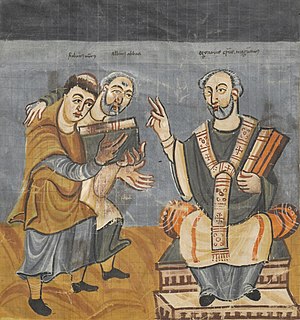
Rabanus Maurus Magnentius, also known as Hrabanus or Rhabanus, was a Frankish Benedictine monk, theologian, poet, encyclopedist and military writer who became archbishop of Mainz in East Francia. He was the author of the encyclopaedia De rerum naturis. He also wrote treatises on education and grammar and commentaries on the Bible. He was one of the most prominent teachers and writers of the Carolingian age, and was called "Praeceptor Germaniae", or "the teacher of Germany". In the most recent edition of the Roman Martyrology, his feast is given as 4 February and he is qualified as a Saint ('sanctus').
Sic et Non, an early scholastic text whose title translates from Medieval Latin as "Yes and No", was written by Peter Abelard. In the work, Abelard juxtaposes apparently contradictory quotations from the Church Fathers on many of the traditional topics of Christian theology. In the Prologue, Abelard outlines rules for reconciling these contradictions, the most important of which is noting the multiple significations of a single word. However, Abelard does not himself apply these rules in the body of the Sic et Non, which has led scholars to conclude that the work was meant as an exercise book for students in applying dialectic (logic) to theology.
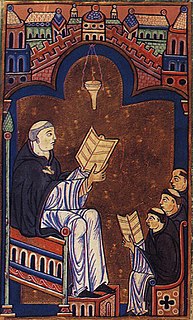
Hugh of Saint Victor, was a Saxon canon regular and a leading theologian and writer on mystical theology.
Agobard of Lyon was a Spanish-born priest and archbishop of Lyon, during the Carolingian Renaissance. The author of multiple treatises, ranging in subject matter from the iconoclast controversy to Spanish Adoptionism to critiques of the Carolingian royal family, Agobard is best known for his critiques of Jewish religious practices and political power in the Frankish-Carolingian realm. He was succeeded by Amulo of Lyons.
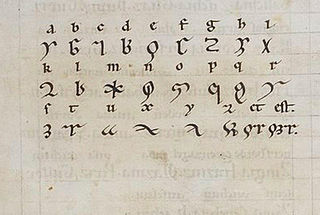
A lingua ignota was described by the 12th century abbess of Rupertsberg, St. Hildegard of Bingen, OSB, who apparently used it for mystical purposes. It consists of vocabulary with no known grammar; the only known text is individual words embedded in Latin. To write it, Hildegard used an alphabet of 23 letters denominated litterae ignotae.
Rauðúlfs þáttr is a short allegorical story preserved in Iceland in a number of medieval manuscripts. The author is unknown but was apparently a 12th–13th century ecclesiastical person. The story is about Saint Olav's visit to a wise man named Rauðúlfr, their entertainment in the evening, the staying overnight in a round, rotating and richly decorated house and a vision the king had in his dream that night. The story is sometimes incorporated in the Separate Saga of St. Olaf.
Marguerite Porete was a French-speaking mystic and the author of The Mirror of Simple Souls, a work of Christian mysticism dealing with the workings of agape. She was burnt at the stake for heresy in Paris in 1310 after a lengthy trial, refusing to remove her book from circulation or recant her views.
Ordo Virtutum is an allegorical morality play, or sacred music drama, by Hildegard of Bingen, composed c. 1151, during the construction and relocation of her Abbey at Rupertsberg. It is the earliest morality play by more than a century, and the only medieval musical drama to survive with an attribution for both text and music.
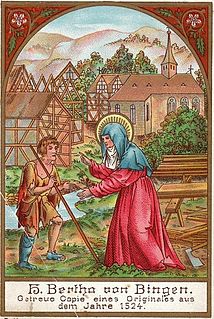
Saint Bertha of Bingen was the mother of Rupert of Bingen. Her biography was written, and subsequently her cult popularized, by Hildegard of Bingen, who lived in the same region, about four hundred years later. Bertha and Rupert share a feast day on 15 May.

Sir Thomas Phillipps, 1st Baronet, was an English antiquary and book collector who amassed the largest collection of manuscript material in the 19th century. He was an illegitimate son of a textile manufacturer and inherited a substantial estate, which he spent almost entirely on vellum manuscripts and, when out of funds, borrowed heavily to buy manuscripts, thereby putting his family deep into debt. Phillipps recorded in an early catalogue that his collection was instigated by reading various accounts of the destruction of valuable manuscripts. Such was his devotion that he acquired some 40,000 printed books and 60,000 manuscripts, arguably the largest collection a single individual has created, and coined the term "vello-maniac" to describe his obsession, which is more commonly termed bibliomania.
Goscelin of Saint-Bertin was a Benedictine hagiographical writer. He was a Fleming or Brabantian by birth and became a monk of St Bertin's at Saint-Omer before travelling to England to take up a position in the household of Herman, Bishop of Ramsbury in Wiltshire (1058–78). During his time in England, he stayed at many monasteries and wherever he went collected materials for his numerous hagiographies of English saints.

Godfrey of St. Victor was a French monk and theologian, and one of the last major figures of the Victorines. He was a supporter of the study of ancient philosophy and of the Victorine mysticism of Hugh of St. Victor and Richard of St. Victor.
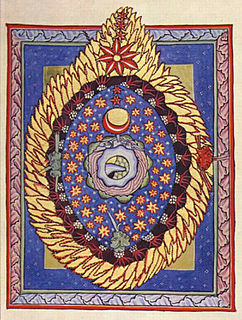
Scivias is an illustrated work by Hildegard von Bingen, completed in 1151 or 1152, describing 26 religious visions she experienced. It is the first of three works that she wrote describing her visions, the others being Liber vitae meritorum and De operatione Dei. The title comes from the Latin phrase "Sci vias Domini". The book is illustrated by 35 miniature illustrations, more than that are included in her two later books of visions.
Barbara Jane Newman is an American medievalist, literary critic, religious historian, and author. She is Professor of English and Religion, and John Evans Professor of Latin, at Northwestern University. Newman was elected in 2017 to the American Philosophical Society.
Beverly Mayne Kienzle retired in 2015 as the John H. Morison Professor of the Practice in Latin and Romance Languages at the Harvard Divinity School, Harvard University. She is a specialist in Christian Latin, Latin paleography, and medieval Christianity. She has published over seventy articles and fifteen books, including five on Hildegard of Bingen. Her latest book is an authoritative biography of her grandmother, Virginia Cary Hudson, author of the best-selling O Ye Jigs and Juleps!.
Richardis von Stade was a German nun and Benedictine abbess of Bassum Abbey. She was a member of the Udonids family as the daughter of Rudolf I, Margrave of the Nordmark and Richardis; and the sister of Hartwig, Count of Stade and Archbishop of Bremen, and Lutgard of Salzwedel, Queen consort of Denmark, Adelheid and Udo. She is best known for her intimate friendship with Hildegard von Bingen.








